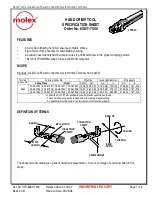
2
Warranty InforMatIon
General warrants its instruments and accessories, and
digital tools products against defects in material or
workmanship for one year from the date of purchase
unless otherwise stated on the packaging, user’s manual,
and/or marketing materials. General also warrants its
nondigital tools products against defects in material or
workmanship on a limited lifetime term. General will
replace or repair the defective unit, at its option, subject to
verification of the defect.
This warranty does not apply to defects resulting from
abuse, neglect, accident, unauthorized repair, alteration, or
unreasonable use of the product. It also does not cover
products purchased from unauthorized distributors. A proof
of purchase must accompany each warranty claim.
Any implied warranties arising from the sale of a General
product, including but not limited to implied warranties of
merchantability and fitness for a particular purpose, are
limited to the above. General shall not be liable for loss of
use of the product or other incidental or consequential
damages, expenses, or economic loss, or for any claim of
such damage, expenses, or economic loss. State laws vary.
The above limitations or exclusions may not apply to you.
For more details or to file a warranty claim, contact General
Tools & Instruments Technical Support at
[email protected]
return for rePaIr PoLIcy
Every effort has been made to provide you with a reliable
product of superior quality. However, in the event your
instrument requires repair, please contact our Customer
Service to obtain an RGA (Return Goods Authorization)
number before forwarding the unit via prepaid freight to the
attention of our Service Center at this address:
General Tools & Instruments
75 Seaview Drive Secaucus, NJ 07094 212-431-6100
3. Center the work piece to be drilled
through in the jig and clamp it tightly
using the black plastic thumbnut
(Callout 9).
4. After making sure that your drill and
bit are up to speed, drill the pocket
hole(s) until the stop collar hits the
metal ring on the top of the jig. For
cleaner cut holes and easier drilling,
do not attempt to drill the entire
depth with one stroke. Instead, use
short strokes until the drill has
reached its final depth. When you’re
finished, unclamp the drilled-through
work piece and remove it from the jig.
5. Clamp the drilled-through work piece and its mate
together in the desired joint configuration (angled, edge-
to-edge, or 90º).
To complete the joints, use the included square drive bit
(Callout 5) to drive screws through the drilled-through
work piece into its mate, adding glue if desired.
6. The vertical piece of the #854 jig can
be separated from the base to create
pocket holes on horizontal work
pieces, or in hard-to-reach areas,
such as corners.
To detach the base of the jig from its
vertical piece, use the included hex
wrench to loosen and remove the
two hex head screws (Callout 11)
that connect the two sections. Two
spare hex head screws are included,
should one or both screws go
missing while the sections are
separated.
7. To use the vertical piece (including
the drilling platform) separately,
follow the same instructions as
above. Use a separate clamp (not
included) to secure the work piece
and vertical piece before drilling.




















